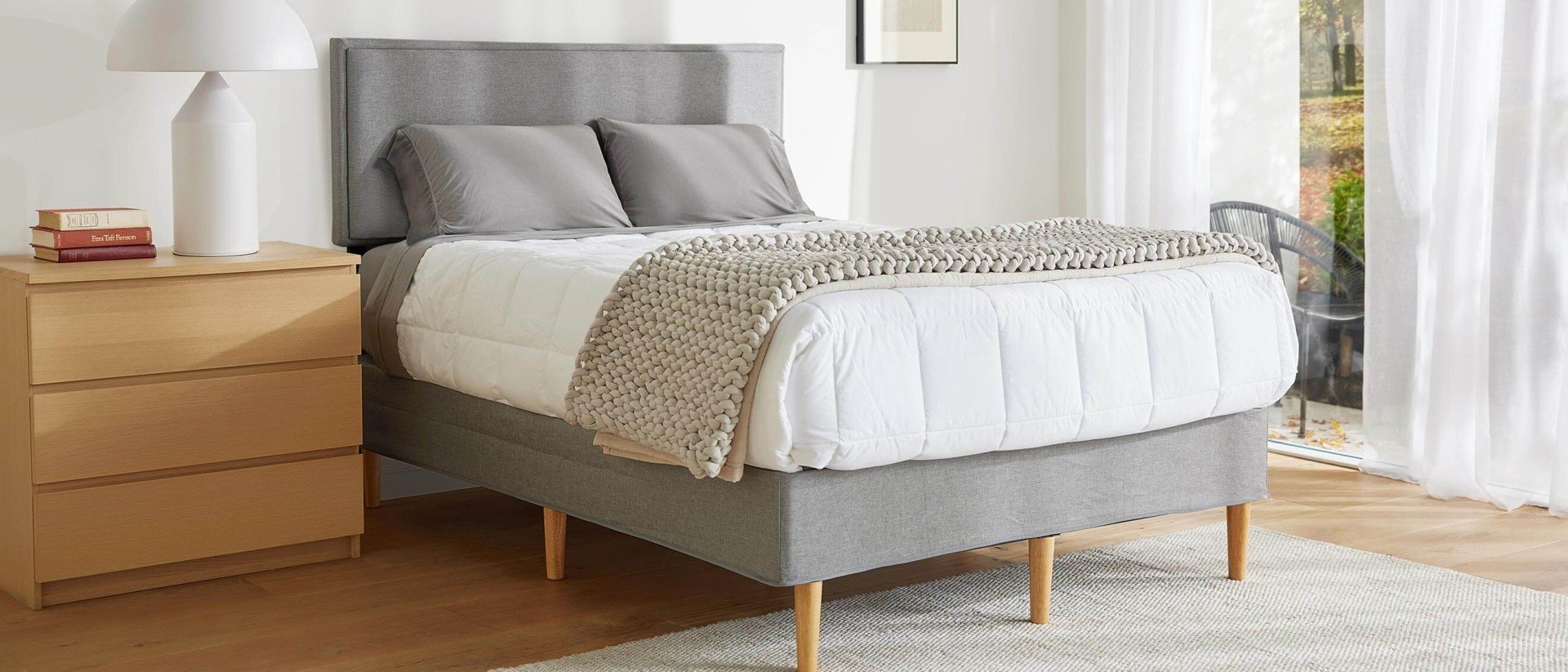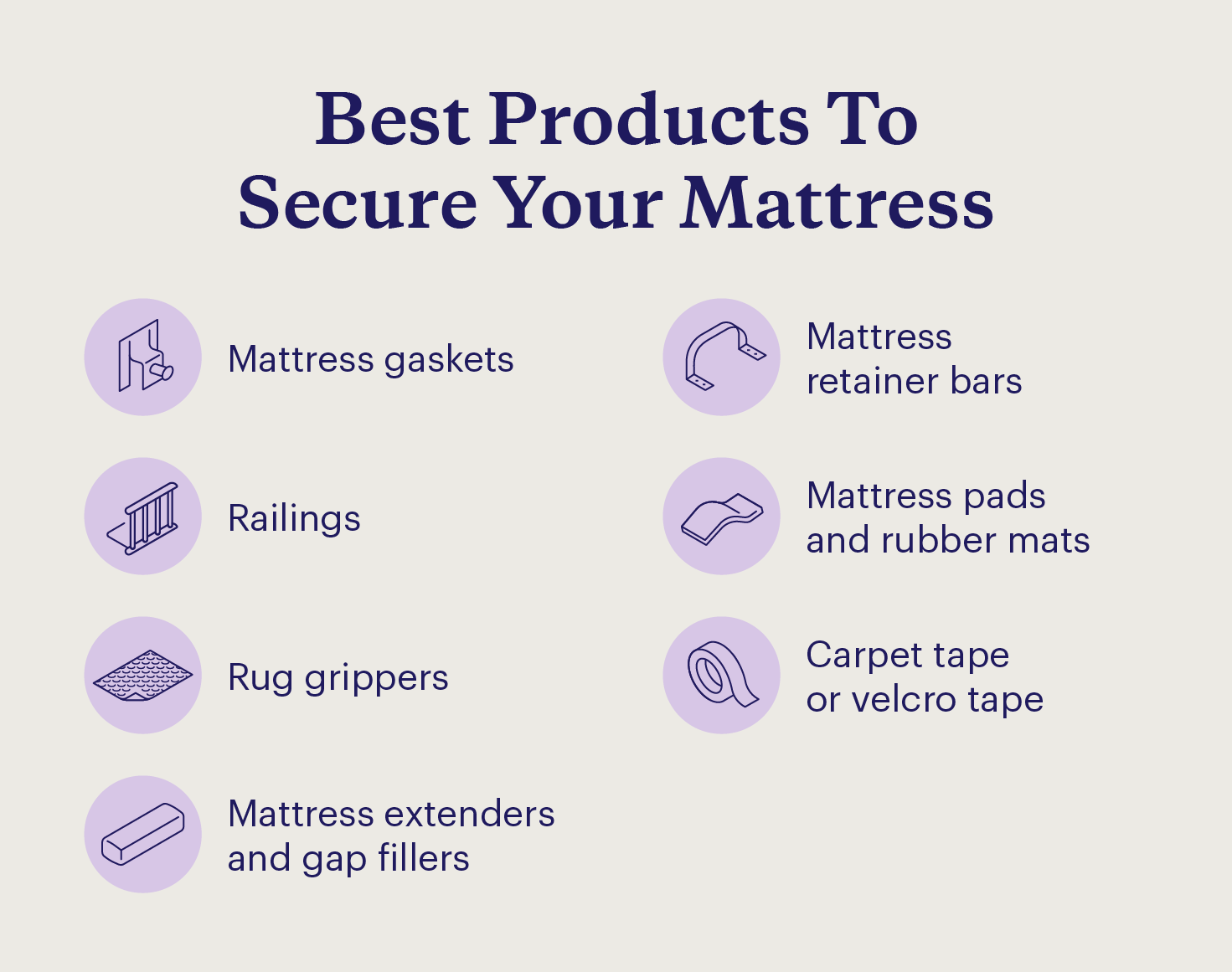
How To Keep A Mattress From Sliding: 11 Solutions To Try + Why It Happens
Key Takeaways
- The best way to keep your mattress from sliding is by choosing the right size bed frame or foundation to keep the mattress in place.
- Mattress gaskets, retainer bars, and railings can help keep your mattress from slipping and hanging over the edge of your bed frame.
- To keep your mattress from moving, try putting carpet tape, velcro tape, a mattress pad, or a rubber mat between the mattress and bed frame.
Have you ever woken up in the middle of the night because your mattress has shifted while you were sleeping? Not to worry—this common problem can be fixed. If the type and size of your foundation doesn’t suit your mattress, learning how to keep a mattress from sliding can keep you comfortable and prevent sleep interruptions.
11 Ways To Stop A Mattress From Sliding
Sleeping on a mattress that consistently slips is uncomfortable, frustrating, and interruptive to the quality and duration of your sleep. Keep reading to learn about the most common causes of a slippery mattress and the best ways to prevent it from sliding.
Why Does My Mattress Keep Sliding?
There are several reasons why mattresses slip on bed frames, bases, and foundations, making it hard for sleepers to get comfortable in bed. Here’s a quick breakdown of the most common causes of a mattress slip-and-slide problem.
Incompatible Bed Frame or Foundation Size
It’s important to get the right foundation or bed frame size for your mattress. If your mattress is too small for the frame, it will have extra space to slide around as you move in your sleep. Similarly, your mattress may hang over the frame if it’s larger than the base, which could cause premature sagging and make your mattress slip.
Not sure if your mattress is the right size for your bed frame, foundation, or base? Learn how to measure a mattress to get your mattress’ dimensions and pair it with the right foundation size.
Insufficient Support
Is your bed frame uneven, or are your bed slats too wide? These issues can make for an uneven sleep surface, which may be the culprit behind your sliding mattress and squeaking bed.
No Railing
Most bed frames have some sort of guardrail to stop your bed from sliding, but simple bases and foundations may not have side rails, headboards, or footboards to help keep the mattress in place. Without these features, your mattress is more likely to move around.
Old Mattress
As you sleep, your body releases oils, sweat, and other secretions that build up in your mattress over time, creating a slippery surface that’s prone to sliding. Your mattress may also shrink slightly and lose its fluffiness or firmness due to constant wear and tear over the years.
A mattress that has shrunk slightly due to age and regular use results in higher chances of slipping while you sleep. If you’ve had your bed for over seven years, it may be time to replace your mattress.
The compatibility of your mattress and bed base can also contribute to unwanted movement. For example, an adjustable base needs a flexible mattress for optimal function.
Lack of Friction
Some mattress materials, like latex or memory foam, are more slippery than others. If your mattress lacks grip against your bed base, it may not have enough traction to keep it securely in place.
Uneven Weight Distribution
Uneven weight distribution may result in localized wear and tear, making your mattress more likely to shift overnight. Your mattress may sag unevenly or slide more if your sleeping partner weighs significantly more or less than you, or if you only sleep on one side of a double bed.
You can help prevent this by regularly rotating your mattress to balance how sleeper weight is distributed and keep your mattress in better condition.
Tossing and Turning
Combination sleepers may find their mattresses shift when they do, disrupting their sleep. While changing position alone may not be enough to make your bed slide off your bed frame, combination sleepers may experience more movement if their mattress and bed frame aren’t a good fit.
For couples who toss and turn, reducing motion transfer in bed can prevent sleep disruptions and limit how much your mattress moves overnight.
Slippery Two-Sided Mattresses
Most modern mattresses are single-sided, but if you have a double-sided mattress, it may slide more than other types of mattresses because both sides have soft outer layers. If you have a two-sided mattress, opting for a single-sided bed instead may solve the issue.
How To Stop A Mattress From Sliding: 11 Tips To Try
A mattress that moves around can be uncomfortable to sleep on. If your mattress keeps slipping and interrupting your sleep, here are 11 tried-and-true options to put an end to your mattress sliding problem and help you sleep more soundly.
1. Use the Right Size Bed Frame
The best way to stop your bed from sliding is to use the correct size bed frame for your mattress. A proper fit ensures that the mattress stays snugly and securely in place no matter how much you toss and turn.
If you’re looking to prevent your bed frame from sliding, your options to increase friction and limit slippage include:
- Non-slip furniture pads
- A rug or carpet
- Rubber mats
Sturdy, low-profile bed frames may be less likely to slide. When paired with the proper size bed, Purple Bed Frames provide ample support for your mattress to prevent sleep disruptions caused by sliding and premature sagging.
2. Mattress Gaskets
If your mattress keeps sliding, you can add hardware to your bed frame to hold it in place. Some of the most popular options include mattress gaskets, which you can affix to a metal frame, panel bed, or platform by screwing them into place.
Mattress gaskets are fairly inexpensive and easy to install, making them a convenient solution to keep your mattress from slipping off the edge of the bed.
3. Mattress Retainer Bar or Slide Stopper
Similar to mattress gaskets, mattress retainer bars or slide stoppers are U-shaped metal rods located at the end of a bed, most commonly on adjustable bed frames. Because of their unique shape, retainer bars slide under your mattress and keep it from skidding forward from the frame.
You can attach this to your bed frame for added security, but if you have a design aesthetic to keep in mind, a footboard may allow you more say in the look and feel.
4. Bed Railings
Most bed frames have edges slightly higher than the slats on both sides of your mattress, but some frames and foundations don’t have this design barrier.
You can install side rails on some metal bed frames, though this is an uncommon solution. Alternatively, adding a bed assist railing can be a good option for those with limited mobility or anyone whose mattress moves too much. A bed railing may not align with your bedroom aesthetic, so other alternatives may be a better fit.
If your bed frame or foundation doesn’t have a headboard or footboard to keep the mattress vertically centered, installing a headboard or a footboard can put an end to your mattress sliding.
For a bed base that holds your mattress in place and maximizes your comfort, try an adjustable base for your bed. Purple’s adjustable bases keep your mattress secure while allowing you to customize your sleep experience and rest more easily.
5. Non-Slip Mattress Pads
Using a non-slip mattress pad can be used in addition to or as an alternative to a mattress protector and mattress cover, providing extra grip to keep your mattress in place.
Place non-slip padding between your mattress and your frame or foundation to give your mattress enough traction to keep it secure. Need a quick fix? Use a yoga mat or thin exercise mat for a twin size mattress and frame.
Opting for a non-slip mattress pad can increase friction to prevent unwanted movement, and using a mattress protector can help keep your mattress pad in place.
6. Rubber Mats
Rubber mats are typically used to line shelves and keep rugs in place, but you can try placing a rubber mattress pad between your mattress and your frame or box spring to keep it from moving. These mats are thin, so they shouldn’t affect the feel or firmness of your mattress.
Take your mattress measurements to cut the rubber mat to the correct size. If your rubber pads are too small for a king or California king, you can put smaller pads beside each other for the right fit. If your padding is too big, trim down with scissors.
7. Rug Grippers
Designed to keep rugs, door mats, and other floor coverings from sliding, rug grippers can also help keep your mattress in place. Inexpensive and available in various sizes, these pads are slip-resistant but easily disengage, allowing you to reposition your mattress as needed without the risk of unexpected shifting overnight.
8. Velcro Tape
Velcro strips are an affordable way to secure your mattress to your bed frame or foundation. Applying velcro tape to the underside of your mattress and slats of your base can keep your mattress from moving around.
While velcro is a cost-effective solution, it can be noisier than other options, and if you toss and turn throughout the night, you might be woken by the sounds of it shifting.
9. Carpet Tape
Double-sided carpet tape isn’t as secure as velcro, but it’s a solid temporary fix for keeping your mattress from sliding on your bed slats, box spring, or platform bed base. Apply it to the head and foot of your bed like you would with velcro strips. Over time, dirt and debris may accumulate, making this method less effective at preventing skidding.
10. Mattress Extenders and Gap Fillers
Mattress extenders, otherwise known as gap fillers or bed joiners, are foam wedges that can fill gaps between your mattress and your bed frame. This creates a snug fit so your bed doesn’t slide around.
This can be an imperfect solution, especially if your mattress is too narrow for your bed frame. If you tend to sleep on the edge of your bed, gap fillers along the sides can be uncomfortable compared to the support of your mattress. Similarly, a difference in feel and firmness at the head or foot of your bed could cause some discomfort.
11. Vacuum Under the Mattress
An excess of dust in your room can create a slippery surface between your bed frame or foundation and mattress. If dust has gathered around your mattress, bedding, or bed foundation, it may be the culprit behind your slip-and-slide woes. Use your vacuum’s upholstery attachment to vacuum under your mattress and give it a better grip on your bed platform.
How Do I Stop My Mattress From Being Slippery?
Adding hardware, non-slip pads, or double-sided tape can keep your mattress from sliding, but the best way to ensure you have the best mattress for minimal partner disturbance is to choose the correct size bed frame or foundation for your mattress.
If you’ve tried these methods but still have sliding issues, you should consider buying a new mattress online or in-store so you can stop sliding and enjoy a good night’s sleep. No matter where you choose to shop, it’s a good idea to test a mattress in store to pick the best model for you.
Opt for a responsive mattress that suits your preferences and provides the pressure relief and spinal alignment you need. All Purple mattresses are made with our proprietary GelFlex® Grid technology that provides support and flexibility with hundreds of air channels to keep you cool.
FAQ
Your mattress may slide around for several reasons, including:
- Insufficient friction
- Too much space between slats or an uneven bed frame
- Lack of rails, headboard, and footboard
- Incorrect mattress and bed frame size
- Active sleepers who toss and turn
- Unbalanced weight distribution
Additionally, if your mattress is old and starting to wear out or you’re using a double-sided mattress, the risk of your bed sliding is higher.
You can put rubber matting or non-slip furniture pads under your mattress so it doesn’t slide on your base, foundation, or frame. These padding items may give your mattress enough grip to stay secure on your bed.
Hardware options like mattress gaskets, retainer bars, and railings can also keep your mattress in place.
Installing a headboard and footboard on your platform bed can help keep your mattress in place, but you can also try securing the mattress to the base with elastic, non-slip pads, and rug grippers.
If your mattress is slipping on your metal frame, try putting non-slip pads, rug grippers, or rubber pads between your mattress and frame to prevent your bed from sliding. Since metal is often more slippery than wood or fabric, installing hardware and adding non-slip solutions is a good way to prevent mattresses from sliding.
If your mattress slides off your box spring, you may need to increase friction between the two. Some of your best options include:
- Rubber mats
- Rug grippers
- Non-slip mattress pads
- Carpet tape
- Velcro tape
You can keep your mattress from sliding on your bed skirt by trying any of the following options:
- Using safety pins to pin the bed skirt to your box spring
- Placing a rubber mat or non-slip pad between the bed skirt and bed frame
- Replacing your old bed skirt with others made from coarser natural materials like cotton
- Adding velcro straps to secure your mattress to your bed frame
If you’re struggling with a mattress topper that won’t stay in place, try:
- Using a tighter fitted sheet
- Tightening your sheets with sheet straps
- Adding velcro strips or carpet tape
- Securing the mattress topper to your mattress or fitted sheet with safety pins
- Placing a non-slip mat between the topper and your mattress
You can fix a gap between mattresses by adding gap fillers or mattress extenders. This provides extra width and length if your mattress is too small and sliding around a larger frame.
Note that while this is less expensive than getting a new mattress, it’s only a temporary solution. The best fix for a mattress gap issue is to pair your mattress with a bed frame in the correct size.
More To Explore
Level up your sleep routine with our most-loved products.











